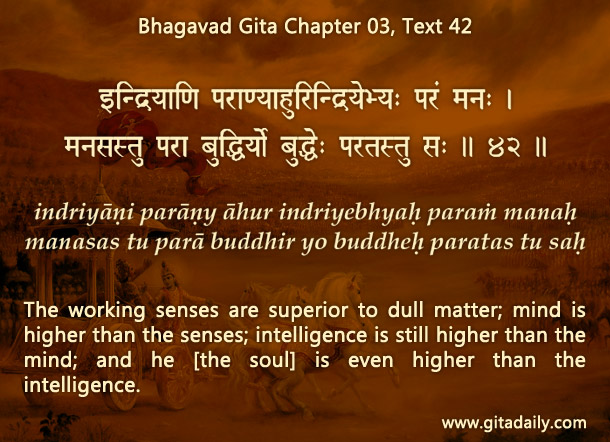Thinking with our sense means using our good sense to differentiate between the desirable and the undesirable. By such thoughtfulness, we see as undesirable the shortsighted desires that promise pleasure but deliver misery. And we see as desirable the farsighted aspirations that, even if requiring initial austerity, lead to enduring happiness.
In contrast, thinking with our senses means letting our thought-process be taken over by the lower desires that are usually associated with our senses.
The Bhagavad-gita (03.42) outlines our inner hierarchy wherein the senses are above the body; the mind above the senses; the intelligence above the mind; and the soul above the intelligence. Though the senses are lower than the intelligence, they can become so forceful as to carry away the intelligence (02.60). That is, the shortsighted desires that drive the senses can take over the intelligence (03.40). When our intelligence is thus hijacked, we can’t use it to give up shortsighted indulgences. Instead, we abuse it to try to maximize enjoyment and minimize its consequences, though such efforts never work out.
To equip our intelligence to resist sensual desires, we need spiritual understanding. Gita wisdom explains that we are non-material beings, parts of the all-attractive supreme Krishna. Consequently, we can find lasting happiness only in loving and serving him, not in pandering to our senses.
Understanding these metaphysical fundamentals changes our inner dynamics. Instead of uncritically going along with sensual desires, as we had been doing earlier, we cautiously choose the desires that harmonize with our real identity. The best such desires are devotional desires, desires that we can nourish by practicing bhakti-yoga. When we no longer let stray desires divert us from our devotional aspirations, we progress undistracted towards fulfilling absorption in Krishna.
Indeed, spiritual self-identification and devotional action comprise thinking with our sense instead of our senses.
To know more about this verse, please click on the image
Explanation of article:
Podcast:


intelligence is the highest emotion